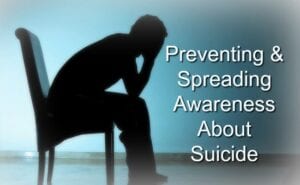 When someone takes their own life, a lot of second-guessing occurs and anyone who’s ever known someone who’s died by suicide has gone through it.
When someone takes their own life, a lot of second-guessing occurs and anyone who’s ever known someone who’s died by suicide has gone through it.
“Why didn’t I see the signs?”
“Why didn’t I just listen more?”
“Why didn’t I just reach out and ask him if he needed some help?”
The list of unanswered questions is never-ending. Suicide is devastating to the victim’s family and friends and can haunt a family for generations. Suicide is a complex public health issue and requires coordination and cooperation among healthcare providers, individuals, family members, and others.
THE SUICIDAL MIND
Most people who are suicidal don’t just wake up one day and say, “Hey, I’m going to kill myself.” People who are suicidal usually go through a set of stages with their suicidal thoughts and feelings. In the Biodyne Model (1), suicide is a three-stage process.
Stage 1 – Ideation stage. Depression is mixed with hopelessness and feelings that things will never change. This is often accompanied by a sense of feeling trapped as if there’s no way out of the circumstances. However, the fear of suicide still outweighs its attraction. Therefore, the person may be thinking dark thoughts or expressing thoughts of death, suicide, pain, and hopelessness through artistic expression, but has not yet begun to formulate a specific plan. People in Stage 1 are not imminently lethal, even though many are involuntarily hospitalized for expressing thoughts of suicide in this stage. Psychotherapy with a well-trained therapist is highly effective and encouraged in this stage.
Stage 2 – Planning stage. During this stage, the person’s dark thoughts begin to turn to formulating a specific plan for suicide. Friends and family may notice the person’s depression worsening, and observe their loved one begin to withdraw. People in Stage 2 are not imminently lethal, although they are in critical need of effective psychological care. Stage 2 rarely lasts longer than several months because it is a very psychologically painful place to be. The person feels compelled to make a decision to suicide (thus moving into Stage 3) or not to suicide at that time; a decision that most people do not discuss with loved ones and often wrestle with in isolation.
Stage 3 – Decision stage. The suicidal person makes the decision to suicide. The moment the decision is made, the person goes on “auto-pilot.” People in Stage 3 are imminently lethal; however, they seem more “normal” than they have seemed in a long time. At this point, the depression seems to suddenly lift because the person has made the decision to die and is no longer wrestling with the decision. Unfortunately, most family members breathe a sigh of relief because their loved one seems so much better. People on “auto-pilot” typically attempt suicide within the next 48 hours. Therapists and family members should be alert to a depressed person who doesn’t seem to improve after months of intervention and then suddenly seems to get better. Instead of relaxing, we should become more vigilant when we see a sudden, overnight improvement.
WARNING SIGNS:
Suicide does not have one single cause. Certain factors like substance abuse and untreated depression can lead to higher risk of suicide just as having a robust social circle can help protect you from suicide. Read more about the warning signs, risk factors and protective factors of suicide.
Warning signs (3) are indicators that a person may urgently need help.
- Talking about wanting to die or to kill oneself
- Looking for a way to kill oneself
- Talking about feeling hopeless or having no purpose
- Talking about feeling trapped or being in unbearable pain
- Talking about being a burden to others
- Increasing the use of alcohol or drugs
- Acting anxious, agitated, or reckless
- Sleeping too little or too much
- Withdrawing or feeling isolated
- Showing rage or talking about seeking revenge
- Displaying extreme mood swings
- Verbal clues (2):
- ‘I’m nothing but a burden to my family’
- ‘They’re so cruel to me. They’ll be sorry some day.’
- ‘Nothing will ever change, will it?’
- ‘Do you think there is any life after death?’
- ‘You’d look after my wife if anything happened to me, wouldn’t you?’
Action clues (2):
- Making very thorough efforts to get affairs in order
- Writing a lot of letters at once to everyone who is significant in their lives (where this is out of character)
- Not wanting to look ahead, or talk about the future
- A sudden surge of energy and apparent sense of peace in someone who has been extremely depressed or distressed
- Stockpiling of medication, either by holding back on prescribed doses, or obtaining medication from more than one source
- Giving away valuable possessions
- Running food supplies down to nothing
WHAT YOU CAN DO
If you are suffering an emotional or suicidal crisis, we want you to know that there is hope and help is available to you.
In an emergency or crisis:
- If you have tried to hurt yourself or have recently attempted, get help immediately by calling 911.
- If you are not hurt, have a friend help you get to the emergency room.
- Call the National Suicide Prevention Lifeline 1-800-273-8255 (TALK).
- Text the Crisis Textline: Text “HOME” to 741-741.
- Use an online chat service.
- See a doctor or mental health professional.
If you are concerned for someone else:
If you are concerned about a friend who may be in emotional crisis or thinking of suicide, don’t hesitate to reach out. There are a number of steps you can take to help ensure their safety.
- Watch for warning signs.
- Talk openly about mental or emotional issues and suicide with a friend, family member, or co-worker.
- Begin a dialogue by asking questions.
- Never keep a plan for suicide a secret. Don’t worry about risking a friendship if you truly feel a life is in danger.
- Don’t try to minimize problems or shame a person into changing their mind. Your opinion of a person’s situation is irrelevant.
- Offer to work together to get help.
Suicidal thoughts are common with some mental illnesses and your willingness to talk about it in a non-judgmental, non-confrontational way can be the help a person needs to seek professional help. Questions okay to ask:
- “Do you ever feel so bad that you think about suicide?”
- “Do you have a plan to commit suicide or take your life?”
- “Have you thought about when you would do it?”
- “Have you thought about what method you would use?”
Asking these questions will help you to determine if your friend or family member is in immediate danger. Acknowledge their pain is legitimate and offer to work together to get help. Make sure you follow through. Help the person find a doctor or a mental health professional, participate in making the first phone call, or go along to the first appointment.
FOR SUICIDE ATTEMPT SURVIVORS
After a suicide attempt, you may feel lost or unsure about the future. A suicide attempt is sometimes more difficult to overcome than the situations or life events that led up to the attempt. The important thing to remember is you are not alone and there are actions you can take immediately to begin the process of recovery.
See a professional. It’s important to see a medical professional or therapist as soon as possible after a suicide attempt. First the doctor will want to test your physical health. Then, a mental health specialist will want to do an assessment of your mental health.
Acknowledge your current thoughts and feelings. Common thoughts and feelings after a suicide attempt may include:
- “Why am I still here? I wish I were dead.”
- “I don’t know if I can get through this.”
- “I can’t do this alone.”
- “How do I tell anyone about this? What do I say to them? What will they think of me?”
- “Maybe someone will pay attention to me now; maybe someone will help me.”
- “Maybe there is a reason I survived. How do I figure out what that reason is?”
Know that you are not alone in your thoughts and feelings. Recovery is possible as long as you are honest in sharing your thoughts and feelings. Know that there are healthier ways to cope with the stressors negatively affecting your life. It can and WILL get better.
Plan what you will say to people. Your friends, family, or coworkers may be surprised, scared for or worried about you after a suicide attempt. To help relieve the stress of explaining to others what happened, come up with the details that you feel comfortable sharing and how you will respond to common questions people may have.
Re-establish connections. Personal relationships and doing the things you once enjoyed can help you feel better. Talk with a mental health provider about ways to get re-connected.
Have a plan to stay safe. Although you may be feeling exhausted, distraught, embarrassed, or a number of other unpleasant feelings, it’s best to focus on creating a safety plan to prevent another attempt. Your therapist will help you come up with a safety plan.
COPING WITH LOSS
If you have lost someone to suicide, the feelings can be overwhelming and can seem unmanageable. For survivors of suicide loss, there are tools (3) available that can help you cope with your grief.
- A comprehensive booklet on suicide grief
- A wallet cardfor survivors of suicide loss: “After a Suicide: Coping with Your Grief”
- Suicide Survivors guide
- Coping With Loss Booklist
- Find a Support Group
- Honor a loved one. Learn more about our Named Memorial Fund
REDUCING ACCESS TO LETHAL MEANS
Restricting access to the lethal means that individuals use to attempt suicide continues to be one of the most successful strategies in reducing suicide death (1). A lethal mean refers to a method in which one uses to attempt suicide.
Medications
- Never keep lethal doses of any medication on hand.
- Keep medications locked in a safe place.
- Properly dispose of medications you no longer need.
Firearms
- Keep firearms locked in a safe and ammunition stored in a separate location.
- Ask a local shooting club or local police precincts to see if they have temporary storage options.
